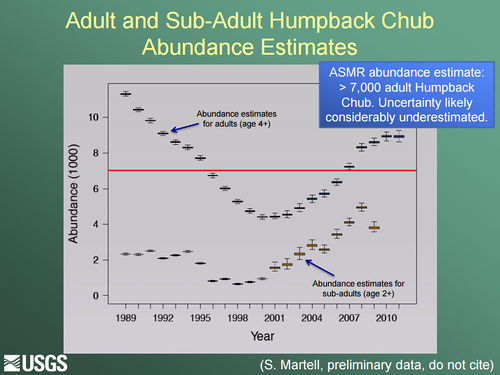Difference between revisions of "Humpback Chub Page"
Cellsworth (Talk | contribs) |
Cellsworth (Talk | contribs) |
||
| Line 173: | Line 173: | ||
'''2021''' | '''2021''' | ||
| + | *[https://www.usbr.gov/uc/progact/amp/twg/2021-04-14-twg-meeting/20210414-LTEMPBiologicalOpinion%E2%80%93HumpbackChubTriggerReviewCurrentStatusUpdate-508-UCRO.pdf Long-Term Experimental & Management Plan Biological Opinion – Humpback Chub Trigger Review & Current Status Update ] | ||
*[https://www.usbr.gov/uc/progact/amp/amwg/2021-02-11-amwg-meeting/20210211-GCDAMPAnnualReportingMeetingUpdateFishes-508-UCRO.pdf GCDAMP Annual Reporting Meeting Update: Fishes ] | *[https://www.usbr.gov/uc/progact/amp/amwg/2021-02-11-amwg-meeting/20210211-GCDAMPAnnualReportingMeetingUpdateFishes-508-UCRO.pdf GCDAMP Annual Reporting Meeting Update: Fishes ] | ||
*[https://www.usbr.gov/uc/progact/amp/twg/2021-01-22-twg-meeting/20210122-TWGMeeting-LTEMPBiologicalOpinionConservationMeasuresUpdate-508-UCRO.pdf Long-Term Experimental and Management Plan Biological Opinion Conservation Measures Update ] | *[https://www.usbr.gov/uc/progact/amp/twg/2021-01-22-twg-meeting/20210122-TWGMeeting-LTEMPBiologicalOpinionConservationMeasuresUpdate-508-UCRO.pdf Long-Term Experimental and Management Plan Biological Opinion Conservation Measures Update ] | ||
Revision as of 15:22, 20 July 2021
|
|
DescriptionThe humpback chub (Gila cypha) is an endangered, native endemic of the Colorado River that evolved around 3-5 million years ago. The pronounced hump behind its head gives this fish a striking, unusual appearance. It has an olive-colored back, silver sides, a white belly, small eyes and a long snout that overhangs its jaw. Like the Colorado pikeminnow and bonytail, the humpback chub is a member of the minnow family. The humpback chub is a relatively small fish by most standards – its maximum size is about 20 inches and 2.5 pounds. By minnow standards it is a big fish, though not like the giant of all minnows – the Colorado pikeminnow. Humpback chub can survive more than 30 years in the wild. It can spawn as young as 2 to 3 years of age during its March through July spawning season. Although the humpback chub does not have the swimming speed or strength of the Colorado pikeminnow, its body is uniquely formed to help it survive in its whitewater habitat. The hump that gives this fish its name acts as a stabilizer and a hydrodynamic foil that helps it maintain position and also probably helped it escape predation by making it difficult to be swallowed by all but the largest pikeminnow. The humpback chub uses its large fins to “glide” in eddy complexes, feeding on insects that become trapped in pockets of slow-moving water. [1] Status and distribution
The humpback chub was listed as endangered by U.S. Fish and Wildlife Service in 1967 and given full protection under the Endangered Species Act of 1973. Historically, humpback chub were probably limited to the eddy complexes of several canyon reaches of the Colorado River and three of its tributaries: the Green and Yampa rivers in Colorado and Utah, and the Little Colorado River in Arizona. The species was first described in 1946. Before that time, few people ventured into these treacherous canyons – including fishery biologists. Today, five self-sustaining populations of humpback chub occur in the Upper Colorado River Basin. Two to three thousand adults can occur in the Black Rocks and Westwater Canyon core population in the Colorado River near the Colorado/Utah border. Several hundred to more than 1,000 adults may occur in the Desolation/Gray Canyon core population in the Green River. Populations in Yampa and Cataract canyons are small, each consisting of up to a few hundred adults. The largest population of humpback chub is found in the Grand Canyon -- primarily in the Little Colorado River (LCR) and its confluence with the main stem Colorado River. In 2009, the U.S. Geological Survey announced that this population increased by about 50 percent from 2001 to 2008 to between 6,000 and 10,000 adults. [2] The 2018 5-Year Status Review concluded that the humpback chub is not in danger of extinction throughout all of its range, but is likely to become so in the foreseeable future; that is, it is a threatened species throughout all of its range. Therefore, the USFWS made a recommendation to downlist the humpback chub to threatened status. [[3] LTEMP Resource Goal for Humpback ChubMeet humpback chub recovery goals, including maintaining a self-sustaining population, spawning habitat, and aggregations in the Colorado River and its tributaries below the Glen Canyon Dam. Desired Future Condition for Humpback Chub• Achieve HBC recovery in accord with the Endangered Species Act (ESA), the HBC comprehensive management plan, and with the assistance of collaborators within and external to the AMP. |
| |
Fish of the Colorado River below Glen Canyon Dam - GCDAMP training prepared by AZFGD |
|
|---|
|
|













